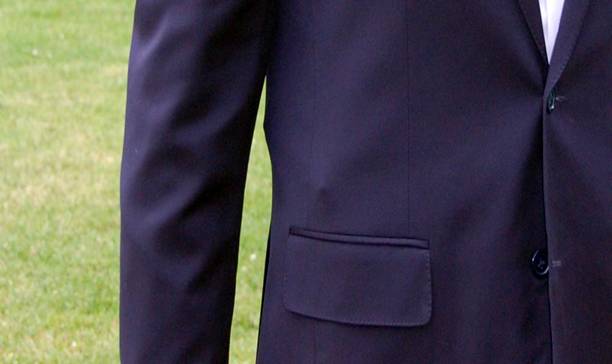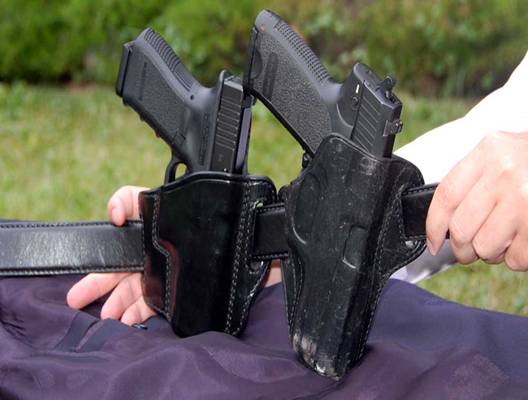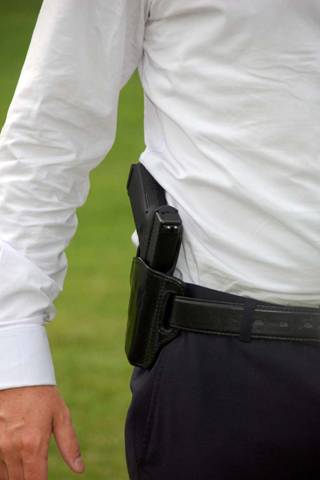There is a large and growing number of people, whether Law Enforcement or concerned citizens, who have chosen to carry concealed firearms. These people are frequently forced to choose between buying an ill-fitting oversized suit or spending a small fortune on a custom suit made by a tailor who often has no idea what the unique requirements of a suit made for Concealed Carry are.
 For the average citizen in most states, the law says that when carrying a concealed handgun, you cannot allow the public at large to know you are carrying or you can face fines and imprisonment or lose the right to carry. For the Law Enforcement professional, it can be even more important to keep the public from knowing that you are carrying. This article endeavors to inform law abiding citizens of what the unique requirements are for those who choose to carry a concealed handgun while wearing a suit.
For the average citizen in most states, the law says that when carrying a concealed handgun, you cannot allow the public at large to know you are carrying or you can face fines and imprisonment or lose the right to carry. For the Law Enforcement professional, it can be even more important to keep the public from knowing that you are carrying. This article endeavors to inform law abiding citizens of what the unique requirements are for those who choose to carry a concealed handgun while wearing a suit.
Here are the five basic types of holsters to carry a concealed handgun:
- The Paddle Holster – The most common type of holster, it is worn at the side, on the belt, on the outside of the pants, and usually at a slight angle forward. A variant of this is the paddle holster worn inside the pants. This holster is very similar to the outside the pants paddle holster, in that it is worn on the belt, at the side, and usually at an angle, but it is worn inside the pants with a clip that goes over the waist line of the pants and attaches to the belt.
- The Small of the Back Holster - This is technically also a Paddle holster, worn on the belt, and the outside of the pants. It is worn at the small of the back and often worn at a significantly greater angle.
- Shoulder Holster - This was a popular way to carry a firearm in the 70’s and is still popular in the movies, however it almost always requires a “Cross Draw” where you carry on one side and draw with the hand.
- The Ankle Holster - As the name implies, this holster is worn on the ankle of either leg. It is much easier to conceal, however very slow to draw.
- Inside the Waist Band (ITWB) – Preferred in plastic by private security forces who appreciate the kydex sheathing’s insulating properties, this holster requires the trousers to be built larger, and is quite popular among a niche group of professionals.
For the purpose of this article, I’ll focus on common paddle holster problems and offer proven solutions.
Common Concealed Carry Clothing Problems & Solutions
 Problem - Concealed Carry & Printing
Problem - Concealed Carry & Printing
The most common concealed carry clothing problem is referred to as “printing”. This occurs when another person can see the outline or “bulge” of the concealed firearm beneath the fabric of the suit. This has become less of an issue since the cell phone started being worn in holsters on the belt, but is still a major problem when looking to choose the right concealed carry clothing. Printing is why people tend to buy oversized jackets; the belief that it is better to look bulky then lean and armed.
Solution
The severity of this issue will depend on the type of firearm you choose to carry. A .45 with a double stack magazine is going to show a lot more than a .40 with a double stack magazine, or a single stack .45 such as the Colt. If I’m able to wear a baggy jacket or oversized photographers vest, I like the HK USP .45, which has a double stack magazine. Those clothes will easily conceal the firearm. If I’m going to wear a suit or something less baggy, I’ll go with the .40 Glock 23. It also has a double stack magazine, but the smaller bullets mean a smaller overall firearm. My point is choose your firearm wisely, especially if you like fitted clothing.
When making a suit to conceal either of the Paddle holsters or Behind the Back holster, you’ll have to add 3-4 inches to the waist measurement of the jacket. This is more difficult than it sounds because it then has to be properly tapered to the armpit. If you’re dealing with a tailor who doesn’t know the purpose of the suit, it’s all too likely he won’t do the taper or the chest correctly. With the Inside the Pants holster, you should also add 2-3 inches to the waist of your trousers. When tailoring for a Shoulder holster you will need to add 2-3 inches to the chest as well as the waist. This is due to the fact that the barrel of the firearm will extend down towards the waist. I would strongly advise you to take all your measurements with your firearm belted on. Another way to help minimize printing is to add an extra layer of lining or canvas to the bottom 12 inches of the jacket. This will add extra stiffness to the part of the jacket that will rest against your firearm and help prevent the printing issue.
 Problem - Concealed Carry & Movement
Problem - Concealed Carry & Movement
Another problem occurs when we raise our arms or are forced to engage in quick movements. In an off the rack suit or one that’s oversized, the bottom of the jacket can rise 4-6 inches and spread at the front, exposing any firearm worn at the side or at the shoulder. This effect is caused by the large arm holes of the jacket that cause the whole jacket to rise when the arms are elevated.
Solution
The key here is to get a jacket with the proper sized arm holes. If you put on an off the rack jacket, you’ll notice the point at which the arm meets the torso under the armpit is a good 3-4 inches below your actual armpit. With a properly fitted suit, that point would only be an inch or two below your armpit. When the arm holes are high like this the fabric pulls up to a lesser degree and offers more freedom of movement when you raise your arms. Also consider adding ½ to 1 inch in length to the jacket. Finally, look to wear a dark colored shirt (to include dark stripes and checks) and jacket & trouser combination; this combination will go a long ways towards keeping your firearm concealed as that if your jacket is opened the dark pistol/holster profile against a dark colored background will be less likely to be noticed.
Problem - Concealed Carry & Environmental Conditions
How often have you worn a suit jacket on the street during a windy day and you have the front flying open? Or on a hot day everyone is peeling off their jackets – suddenly you’re being asked to relax and follow suit.
 Solution
Solution
To address the wind problem, the best option is to choose a jacket with a square edge front. More material here will naturally be more resistant to flapping open and revealing your concealed carry. To reinforce this, or to augment a curved front, sew a small fishing weight at each of the bottom front corners of the suit jacket. These weights serve to help both the concealment and speed concerns; the added weight keeps the wind from blowing your coat up and allows you to flip the fabric out of your way before you draw your weapon. A tailor can sew the weights into the canvas so that they never fall off, and a custom clothier can even create hidden pockets so you can experiment with different weights or increase it with pocket change on a windy day.
As for heat, look to unlined jackets or using a fabric such as mohair, linen or a lightweight cotton that breathes and allows heat to dissipate. Be careful of lighter colored jackets though as they are more likely to print. Instead look for a busy fabric pattern or solid dark color that helps offset this problem. Also avoid fabrics such as polyester; they do not breathe or drape well and will have you drenched in sweat.
Final Point
Practice putting yourself together before you need to wear the concealed carry outfit. Know which clothing combinations work, which ones have issues, and then dress with confidence knowing you have taken precaution to ensure you are carrying your firearm legally.
Editor's Note: As a former Marine Officer and the owner of ATailoredSuit.com, Antonio is an expert when it comes to concealed carry. Check out the top 10 tips on how to properly carry a concealed weapon when wearing a men's suit or blazer now to learn more!
 About The Author:
About The Author:
Antonio Centeno is the founder of ATailoredSuit.com, an online custom clothier that helps men create clothing that best suits their individual style. He has a BA from Cornell College and MBA from UT Austin. Over the years he has refined his foundation in the understanding of men's fashion by studying style in London, Hong Kong, Los Angeles, and Bangkok. He has authored over 300 articles on men's style and has been quoted in the New York Times, Time Magazine, and CNN. Previously he served as a Marine Officer with the 1st Marine Division.
 For the average citizen in most states, the law says that when carrying a concealed handgun, you cannot allow the public at large to know you are carrying or you can face fines and imprisonment or lose the right to carry. For the Law Enforcement professional, it can be even more important to keep the public from knowing that you are carrying. This article endeavors to inform law abiding citizens of what the unique requirements are for those who choose to carry a concealed handgun while wearing a suit.
For the average citizen in most states, the law says that when carrying a concealed handgun, you cannot allow the public at large to know you are carrying or you can face fines and imprisonment or lose the right to carry. For the Law Enforcement professional, it can be even more important to keep the public from knowing that you are carrying. This article endeavors to inform law abiding citizens of what the unique requirements are for those who choose to carry a concealed handgun while wearing a suit.  Problem - Concealed Carry & Printing
Problem - Concealed Carry & Printing Problem - Concealed Carry & Movement
Problem - Concealed Carry & Movement Solution
Solution About The Author:
About The Author:
